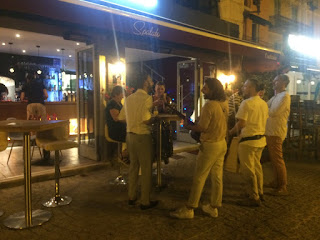Day 1147 (Thursday) 30th July 2020
We had a great night last night and stayed out the latest for a long time and on a school night as well. There was another terrace party night when they close some of the roads and spread the tables and chairs across the road and the atmosphere was electric.


I managed to get a photo of these dancers without having to tip them.
There was love music everywhere and people were joining in and dancing in the streets.
It was filthy hot this morning and it was a struggle to get out of bed after a late night.
The kids weren’t quite as bad as they were yesterday but it was still a long three hours. I saw a great example of French parking on the way back to the station – both of these cars were parked on this zebra crossing – you’ve got to love them,
When I got home I got a text from the guests staying at the villa saying that they left and were on their way to the airport so Huw went up to check that everything was OK and it was. While he was waiting for the washing machine he had a dip in the pool.
I sunbathed again and prepared tomorrow’s class – the last one – hooray! Of course Badger helped me enormously…not!
The Ancient French Diet: A Brief History and Timeline of French Food
Until the day the Bastille was stormed in 1789, 70 percent of French citizens were peasants and poor farmers whose diets were based mainly on grains. Bread was the primary component of their diet.
When the grain crops failed in 1788 and 1789, bread became so expensive that only the aristocrats could afford it and, if it appeared on one's table, it was a mark of social standing. Without his nutritional mainstay, the common man was starving.
Food and The French Revolution
This physical hunger and the hunger for liberté, egalité, fraternité (liberty, equality, fraternity) were the impetus for the French Revolution. After the uprising, many cooks and servants, whose aristocrat employers had fled Paris or were executed, opened restaurants and made finer foods available to the common man. Now anyone could saunter into a tavern or restaurant, have a substantial meal, and be able to pay for it without robbing a bank.
19th Century and Haute Cuisine
Georges Auguste Escoffier is considered to be the founder of haute cuisine or gourmet French food. During his tenure at some of the great hotels in Europe and America during the 1880s to 1890s, he instituted the brigade system in which professional kitchens are separated into five stations:
Garde manger: This is the chef responsible for preparing cold dishes.
Entremettier: Starches and vegetables are prepared by this chef.
Rôtisseur: This is the chef who oversees the preparation of roasts, grilled, and fried items.
Saucier: This exalted position is relegated to the chef who prepares exquisite soups and sauces.
In this way, with each chef preparing a component of the dish, it takes much less time than if one chef prepared one dish from start to finish. Thus, meals could be served faster and tables turned over more quickly (i.e., more money could be made).
Escoffier introduced a lighter approach to classic sauces to enhance a dish rather than mask its flavours. He also took peasant dishes and transformed them using the refined techniques of haute cuisine.
20th Century Changes
World War I heralded the beginning of modern French cuisine. Improved transportation during the first half of the 20th century spread the wealth and regional cuisine that had previously been segregated.
World War II veterans, who had experienced the glories of European sights and cuisine, created a flurry of tourism that furthered the need for grand cuisine at a fair price.
In the 1960s, a new way of cooking helmed by chef Paul Bocuse and others emphasised freshness, lightness, and clarity of flavour in a movement known as nouvelle cuisine.
This new way of cooking got rid of unnecessary and complicated steps. Food was not cooked to death in order to preserve more of its natural flavours. Steaming came into vogue and the emphasis was on the freshest ingredients possible. Heavy sauces thickened with roux were given the boot in favour of butter, lemon, and fresh herbs. Similarly to what Escoffier had done, regional or peasant dishes were the inspiration for a new "clean" approach to cooking.
By the mid-1980s, however, nouvelle cuisine had reached its saturation point and many chefs began returning to the haute cuisine style of cooking, although much of the lighter presentations and new techniques remained.
Today’s French Kitchen
Today, French cuisine rides a fine line between haute and nouvelle styles. What remains the same since the 19th century is that fine food is available to everyone, no matter one's income or station in life.
Ubiquitous bistros and cafés now dot the land and the French have their pick of pain au chocolat or brioche daily. In France, there is an eatery for everyone. Attention is paid to the quality, flavour, and appearance of food. It is a pure, nearly religious, sensory experience. What once was subsistence is now an object of daily, living art.















Comments
Post a Comment